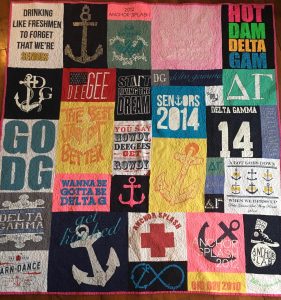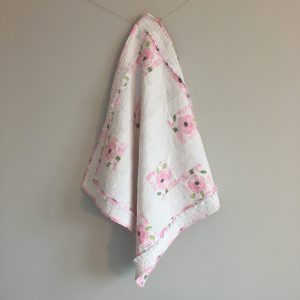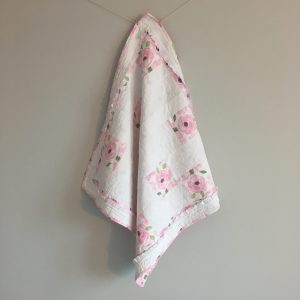If you know me, you know that I love quilting. Something about taking all these tiny, mismatched pieces of fabric and joining them into a cozy blanket is more than a hobby. It is an expression of love.
The ABC’s of Quilting
Quilting has its own vocabulary. A Quilt is the finished product, a ‘sandwich’ of at least two pieces of fabric on either side of a piece of batting (thick fabric usually cotton but sometimes wool that adds weight to the finished quilt) held together by stitching. Quilting is the act of stitching them together. Quilting can be done by hand, by domestic machine, or by a specialized long arm machine that allows for programed designs and/or really complex free motion quilting. A Quilt block is a small design (usually square) which tends to show a distinct pattern. A Quilt Top is the patchwork pretty side of the quilt, traditionally made up of multiple Quilt Blocks. Some quilts display artistry in the use of fabric, others display it through the quilting itself to create the design. Others play between the two. One of my favorite quilt artists is Bisa Butler, her work is currently being exhibited at the Art Institute of Chicago.

I have made quilts in many different ways. I have made mosaic t-shirt quilts that are beautiful for their randomness (despite the effort it takes to actually make them look random). I have made delicate baby quilts with patterns I have drawn out myself using grid paper and excel documents. I have even followed traditional patterns that I have purchased from quilt designers or quilting companies. One such pattern is the Antique Lace Quilt by Missouri Star Quilt Company. I love this quilt. I have made it twice now.
IP and Crafting Arts
Recently in my IP colloquium course, we read a paper discussing gender and race in trademark prosecution. The paper gave a brief interlude into race and gender in patent applications and copyright registration. In regard to copyright registration the authors mentioned a curious detail about female creators. In her paper, A Feminist Exploration of the Legal Protection of Art, Shelley Wright details how female artists and authors are generally considered creators of ‘crafts’ and ‘domestic arts’ rather than authors. As a result, their works are considered below the minimum threshold for legal protection. This made me wonder about the protection quilt designers had for a quilt top.
For a work to be copyrighted it must be original to you, fixed in a tangible medium with minimal creativity, and not subject to any statutory bars. The copyright standard for originality is pretty simple, it must just be original to you, not copied. However, the competition standard for an original quilt is pretty high.
Quilting competitions (yes those exist) have strict guidelines regarding what makes a quilt original or derivative, and when design credit should be granted. A derivative quilt is one made from a known pattern, that utilizes part of a known pattern or one that reproduces art in the quilt medium. An original quilt, on the other hand, is one that may take inspiration from another work but alters the work so much that it would be unrecognizable as another’s design.
The Quilting Copyright Question
For this exercise, let’s say that my quilt top is 100%, competition standard original to me, with no entire blocks from other designers or the public domain.

Fixed in a tangible medium and minimal creativity are easy hurdles for quilters to overcome. The quilt top itself is fixed in a tangible medium (it’s a solid thing that you can touch) and as its 100% original to me. With some non-trivial design that I created, it will meet the low threshold for minimal creativity that only bars the most obvious things like basic shapes.
Quilters hit a snag however, when the statutory bars are added. Those statutory bars include a bar on “useful articles”. A useful article is an object having an intrinsic utilitarian function that is not merely to portray the appearance of the article (e.g., a painting) or to convey information (e.g., a map). Quilt tops are useful in that they keep you warm.
There is, however, a work around for this statutory bar. Under 17 U.S.C. §101 the design elements of useful articles can be copyrighted if they are “separable.” This means that they can be identified separately from, and are capable of existing independently of, the useful aspects of the article. The case Star Athletica v. Varsity Brands created a two-part test to use for this analysis;
- Can the design feature be perceived as a two- or three-dimensional work of art separate from the useful article?; and
- If so, would that feature qualify as a protectable work – on its own or in some other tangible medium of expression – if imagined separately from the useful article into which it is incorporated?
So how does this apply to a quilt top? can the quilt top be perceived as art separately from the function of the quilt itself? Likely yes. If you look at winning competition quilts from the past few years, they can be perceived as art. If one of these were on a canvas or hung from a wall (as they often are), it would seem to be a two dimensional work of art. So, the next step is to determine whether the design is protectable. Basically this goes back to whether it meets the minimal standard of creativity, which we already decided it does. Even my sorority t-shirt quilt (pictured above) while not competition worthy is very much copyrightable.
But there are actually lots more questions. For example, what if I want to make a pattern for my original quilt, and sell instructions on how to make it? Can I copyright those instructions? What if I take someone else’s commercial pattern and make my own quilt? Is that copyrightable? What if I combine commercially available blocks with blocks that are in the public domain? Or create a quilt entirely of publicly available blocks that have never been paired together?
Check out Part 2 of Quilting and Copyrighting to find out!
Lily Parker
Associate Blogger
Loyola University Chicago School of Law, J.D. 2022
